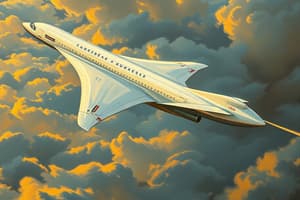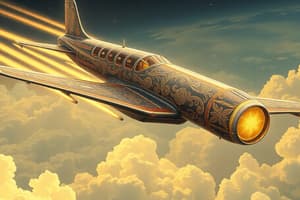Podcast
Questions and Answers
The Concorde reached speeds of up to Mach 2.04, approximately 1,354 miles per hour, and could cross the Atlantic in less than three hours, showcasing its impressive ______.
The Concorde reached speeds of up to Mach 2.04, approximately 1,354 miles per hour, and could cross the Atlantic in less than three hours, showcasing its impressive ______.
speed
The Concorde's success was hindered by the significant energy required to maintain supersonic speeds and the resulting ______, leading to restrictions on supersonic flight over land.
The Concorde's success was hindered by the significant energy required to maintain supersonic speeds and the resulting ______, leading to restrictions on supersonic flight over land.
sonic boom
The Concorde was limited to supersonic flight over the ocean due to concerns about the impact of its sonic boom on ______ areas.
The Concorde was limited to supersonic flight over the ocean due to concerns about the impact of its sonic boom on ______ areas.
land
Despite its impressive speed capabilities, the American SST never entered commercial service due to concerns about sonic booms and ecological ______.
Despite its impressive speed capabilities, the American SST never entered commercial service due to concerns about sonic booms and ecological ______.
The pioneering work during the development of the SST paved the way for advancements in aviation, particularly in the realm of lighter, more fuel-efficient, and quieter ______.
The pioneering work during the development of the SST paved the way for advancements in aviation, particularly in the realm of lighter, more fuel-efficient, and quieter ______.
Companies like Boom Supersonic and Spike Aerospace are currently developing new SSTs with the goal of providing faster, more efficient, and environmentally sustainable options for global ______.
Companies like Boom Supersonic and Spike Aerospace are currently developing new SSTs with the goal of providing faster, more efficient, and environmentally sustainable options for global ______.
The race to break the sound barrier in the mid-20th century captured the public's imagination, with prolific figures like Chuck Yeager and the Bell X-1 paving the way for futuristic transportation ______
The race to break the sound barrier in the mid-20th century captured the public's imagination, with prolific figures like Chuck Yeager and the Bell X-1 paving the way for futuristic transportation ______
Designers, engineers, and physicists began to envision aircraft capable of crossing the Atlantic in mere hours, rather than the then-standard eight to twelve ______
Designers, engineers, and physicists began to envision aircraft capable of crossing the Atlantic in mere hours, rather than the then-standard eight to twelve ______
The first serious proposals for SSTs emerged in the ______ with names like the British-French Concorde and the American Boeing 2707 leading the field
The first serious proposals for SSTs emerged in the ______ with names like the British-French Concorde and the American Boeing 2707 leading the field
The Concorde, which first flew in 1969, is the most famous and successful SST in ______
The Concorde, which first flew in 1969, is the most famous and successful SST in ______
The Concorde enjoyed a 27-year operational life from 1976 to ______
The Concorde enjoyed a 27-year operational life from 1976 to ______
The British-French Concorde and the American Boeing 2707 showcased the feasibility of supersonic travel, generating excitement and anticipation for the future of ______
The British-French Concorde and the American Boeing 2707 showcased the feasibility of supersonic travel, generating excitement and anticipation for the future of ______
Flashcards are hidden until you start studying
Study Notes
The Evolution of SST: From Early Concepts to Modern Day Applications
SST, or Supersonic Transportation, is a game-changing innovation in aviation that harnesses the power of supersonic speeds to dramatically reduce travel times across the globe. To grasp the full significance of SST, let's delve into its historical origins and the technological advancements that have shaped its course.
Early Concepts: Reaching for the Unreachable
In the mid-20th century, the race to break the sound barrier captured the public's imagination, with prolific figures like Chuck Yeager and the Bell X-1 paving the way for futuristic transportation concepts. Fascinated by the potential for faster travel, designers, engineers, and physicists began to envision aircraft capable of crossing the Atlantic in mere hours, rather than the then-standard eight to twelve hours.
The first serious proposals for SSTs emerged in the 1950s, with names like the British-French Concorde and the American Boeing 2707 (later renamed the SST) leading the field. These designs showcased the feasibility of supersonic travel, generating excitement and anticipation for the future of aviation.
The Concorde Era: A Tale of Two Nations
The Concorde, which first flew in 1969, is the most famous and successful SST in history. It was developed by a joint project of Britain and France and enjoyed a 27-year operational life from 1976 to 2003. With its distinctive delta-wing design, the Concorde reached speeds of up to Mach 2.04 (approximately 1,354 miles per hour) and was capable of crossing the Atlantic in less than three hours.
The Concorde's success was not without its challenges. Due to the considerable energy required to maintain supersonic speeds and the resulting sonic boom, it was restricted to supersonic flight over the ocean only. Additionally, its high operating costs made it a niche product, with only 20 aircraft ever produced, leading to its eventual retirement.
The SST and Beyond: Redefining Global Transportation
The SST, an American design, never entered commercial service. Despite its impressive speed capabilities, reaching Mach 2.58 (approximately 1,805 miles per hour), its development was halted in 1971 following concerns about sonic booms and ecological impacts. The pioneering work carried out during the SST's development, however, paved the way for future advancements in aviation, particularly in the realm of lighter, more fuel-efficient, and quieter aircraft.
Fast-forward to the present day, and supersonic air travel is once again on the horizon. Companies like Boom Supersonic and Spike Aerospace are developing new SSTs, with the goal of providing faster, more efficient, and environmentally sustainable options for global transportation.
Challenges and Opportunities for the Future of SST
The future of SST is not without its challenges. Sonic booms and environmental concerns continue to be a focus for research and development. Newer designs aim to minimize the impact of sonic booms on the ground, while also improving fuel efficiency and reducing carbon emissions.
In addition to addressing these challenges, there are exciting opportunities for SSTs to revolutionize global travel. The ability to travel greater distances in a shorter amount of time could facilitate faster growth of international businesses, reduce carbon footprints, and improve the quality of life for individuals and families.
As we continue to explore the potential of SSTs, it is essential to maintain a commitment to safety, efficiency, and environmental sustainability. By addressing the challenges of the past and embracing the opportunities of the future, SSTs have the potential to redefine global transportation, making the world a smaller and more connected place. "Supersonic Transportation History and Timeline," FlightGlobal, accessed February 24, 2024, https://www.flightglobal.com/learn/history-supersonic-transportation/ "Concorde: The History of the World's First Supersonic Airliner," Air & Space Magazine, accessed February 24, 2024, https://www.airspacemag.com/flight-today/concorde-history-180963382/ "SST: The Aborted Supersonic Jet," Smithsonian National Air and Space Museum, accessed February 24, 2024, https://airandspace.si.edu/collection-objects/sst-the-aborted-supersonic-jet "Supersonic Transportation: Challenges and Opportunities," NASA, accessed February 24, 2024, https://www.nasa.gov/feature/supersonic-transportation-challenges-and-opportunities
Studying That Suits You
Use AI to generate personalized quizzes and flashcards to suit your learning preferences.





